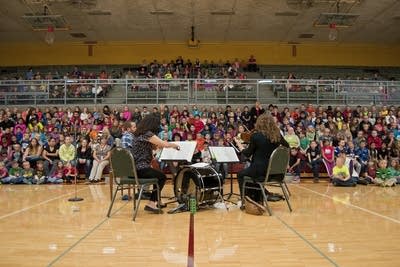
Did you know that one can play a violin using a folded-up piece of paper like a bow? Well, prior to watching the Mill City String Quartet perform their Class Notes Artist program, it had never even crossed my mind … and I'm a string player.
The piece I am referring to is a whimsical tribute to both the sounds of Japanese music and to Origami, the Japanese art of folding paper. Cleverly titled "Ear-igami", the music details how the players should — besides traditional pizzicato — shake, swish and "bow" the folded paper to create unusual sound effects on their instruments.
The quartet's "world tour" program spanned dance music from Argentina and France, folk music from Italy and China, a "bluegrass" string quartet from America, and traditional string quartet literature by Antonín Dvořák and Alexander Borodin representing the Czech Republic and Russia, respectively. (Though admittedly the Dvořÿk selection was actually from his "American" string quartet, composed during his 1893 summer holiday in the Czech haven of Spillville, Iowa, located an average of 150 miles from these participating schools).
The students were encouraged to listen for certain elements in each of the pieces, whether it was following the melody as it was passed from player to player, or bluegrass style double-stops (playing two notes at a time on two strings), or the sliding style of playing typical of Chinese music.
The quartet didn't limit to themselves their typical string quartet instruments as they introduced their young audiences to arrangements for string quartet representing Japan, Kenya and Mexico, employing the aforementioned paper, a kick drum, a tambourine, and student volunteers to accompany them on the kalimba (African "thumb piano") or shakers. Audience participation in the form of clapping was encouraged on a couple of pieces, while some students were simply inspired on their own to quietly conduct or to "air-bow" throughout the concert.
At the majority of the schools, the quartet received what could best be described as the raucous applause and cheers usually reserved for rock concerts. At one school, the students even swarmed the quartet after the concert to ask for autographs and photographs (almost none of the kids had paper so they had the quartet sign their hands and arms). However, at another school, the audience were so quiet and rapt with attention during the performance, you could almost feel them focusing.
It is really fascinating how the students react to the same Artist at each different school. Their enthusiasm for the live performance, however it manifests itself, is always a powerful thing to observe.
Audio
Alexander Borodin: String Quartet No. 2 — I. Allegro moderato
Antonín Dvořák: String Quartet No. 12, Op.96 "American" — I. Allegro ma non troppo
Schools
Blue Earth Elementary — Blue Earth, Minn.
Winnebago Elementary — Winnebago, Minn.
Northside Elementary — Saint James, Minn.
Chatfield Elementary — Belle Plaine, Minn.
Oak Crest Elementary — Belle Plaine, Minn.
Montgomery Elementary — Montgomery, Minn.
Le Center Elementary — Le Center, Minn.
Lonsdale Elementary — Lonsdale, Minn.
About the Classical MPR Class Notes Artists program
Now in its sixth year, the Class Notes Artists program at Classical MPR brings performers to elementary schools throughout the state of Minnesota to give educational concerts. Each performance includes a presentation about the Artists' respective instruments, as well as the style, technique, history, and traditions related to the music that they perform.
The Artists are selected for the quality of their musicianship, and for their interest in promoting music education. Over the next few months, the following Artists will collectively travel to 60 schools in four different geographical hubs.
Belladonna Baroque Quartet — Twin Cities
Excelsior! Trio — Northwestern Minnesota
L'unica Trio — Saint Cloud area
Lyz Jaakola — Twin Cities
Mill City String Quartet — Southwestern Minnesota
The Mirandola Ensemble — Twin Cities
Minnesota Percussion Trio — Twin Cities
Summit Hill Brass Quintet — Twin Cities
These performances are supported by Minnesota music education standards-based curriculum designed by Classical MPR's Curriculum Specialist. These lessons and activities are given to music teachers in advance of each Artist's visit, and are to be used as learning materials for before and/or after each performance.
Students at participating schools will also receive an MPR-produced compilation CD featuring the year's Artists, allowing students to experience a wide range of different musical styles and ensembles. The 2014-15 album, Bach, Birds, and Blues, is also available to stream online.
Classical MPR's goal for the Class Notes Artist program is to create authentic and transformative experiences for young pupils that will inspire their creative pursuits, and be a meaningful addition to what they are already learning from their music teachers.
Love the music?
Show your support by making a gift to YourClassical.
Each day, we’re here for you with thoughtful streams that set the tone for your day – not to mention the stories and programs that inspire you to new discovery and help you explore the music you love.
YourClassical is available for free, because we are listener-supported public media. Take a moment to make your gift today.



